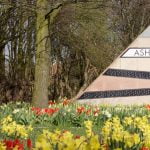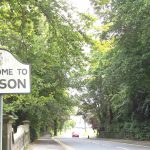Once the most popular market town in the north, could Morpeth be your next holiday destination? We say aye.
Morpeth is a popular town in Northumberland that has a population of around 14,000 people. The town once had not once, but two castles. The first mention of it in historical records is from 1080, but give us a sec and we’re pretty sure we can find history going on here before then. Let’s jump into the early history of Morpeth, to begin with, because we all like a bit of history, don’t we?
Early Days of Morpeth
So that first early mention of Morpeth involves William de Merlay. He built an old-school motte and bailey castle on Haw Hill. Those eagle-eyed among you will spot the ‘de’ and realise he was a Norman. He was assigned the title of Baron by William the Conqueror and chose Morpeth for his castle. As an interesting side note, the Normans really struggled to control the north and a large part of that meant building multiple castles. The north of England has so many castles because Big Willy was scared he would lose control.
Morpeth was occupied in the Iron Age. There is evidence of a Romano-British farmstead settlement. You might be surprised to find out that Northumberland has Iron Age settlements all over the place. There are also many rock marks and carved symbols which form a sort of early human code. About 7 miles west of Morpeth you will find Slate Hill Settlement. This was a defensible site where people probably lived together for safety.
Romans came to Morpeth at the beginning of recorded history. In fact, we have much of our early knowledge of most towns thanks to their meticulous records. Prior to the Romans and even after, with the Vikings, people thought that writing things down was witchcraft. That is why we call it ‘spelling’ because we are casting spells with our words. It’s no surprise then that the people who wrote things down after that were the Catholic church. The greatest wizards of all. The Romans were up here building walls and fighting off the mad Scots. Eventually they slammed up the wall and went home. Most of our current roads were Roman built. The Romans retreated from England around 40AD, leaving empty settlements and villas behind. Some of them stayed on, so we do have some Roman blood in us to this day.
The kingdom of Northumbria lasted from 450-866AD, which means the Vikings probably ended it. A little more research shows our guess was right. The Vikings invaded Lindisfarne. They became established in the south from then onwards, with frequent raids. In 866AD a large army of them came up from Anglia. If you ever watched Vikings the TV show, then you know who Ivar the Boneless is. He was a Viking given the title of Berserker: a status reserved for the hardiest, most brutal warriors. Famously he couldn’t walk, proving that you shouldn’t diss anyone’s ability. The Danes arrived knowing the northern kingdoms were at war with each other and took advantage of it to establish themselves in the north. So, if you live in Morpeth, you could have Roman or Viking, Norman, Anglo-Saxon, or Celtic blood.
The Medieval Era in Northumberland
All this means that by the time 1080 motte and bailey castle was the result of many years of northern disgruntlement. Now that we have set the background, let’s move on to Morpeth’s medieval history.
Firstly, despite its castle, there are no records of Morpeth appearing in the Domesday Survey of 1086. The inspectors didn’t go this far north. Instead, we have to go by church records and town history. In 1138 a Cistercian Abbey opened in Newminster to the west. As of 1199, the town gained its first charter allowing them to hold a market every week. It was then that Morpeth’s long history as a market town came into play.
Now… you remember Robin Hood? The king John who granted Morpeth its first charter is the same John that the Sheriff of Nottingham worked for. The tale goes that John bled the poor for taxes while he reclined in great wealth. Imagine him as the English Marie Antoinette. People were annoyed at best, and rebellious at worst. Unfortunately Richard the Lionheart would never return from his crusades and the people were stuck with John. However, he is the one who granted the Magna Carta in 1215AD. He immediately tried to revoke it after he realised what he had signed, but he was unsuccessful and to this day you can grow food in your own garden because of it… among other important rights.
King John’s barons hated him with a passion, so much so that they went to war with him. John fought the First Barons War from 1215 until his death in 1216. Basically, all his barons rebelled against him. In the north, that rebellion favoured the barons instead of the rich and frivolous king. Stories just like Robinhood began circulating, and despite his death, John’s bad deeds were immortalised in the story.
What has all this to do with Morpeth? When the king’s forces arrived in Morpeth they straight up razed the original castle to the ground to stop the Barons sheltering there. It was rebuilt later, but John definitely left his mark on the north.
In 1239 the Baron of Morpeth, who seemingly survived, gave his permission for the building of the oldest street in Morpeth. Funnily enough, its name is Oldgate. During this century the wooden bridge across the Wansbeck became stone and the Chantry Chapel was built. We don’t have the exact dates.
Let’s call it time on the medieval period. We hope you found it as fascinating as we did. We will pick it up again after this short intermission.
Fun Facts About Morpeth
We don’t let any travel guide slip by without pointing out all the gossip we can scrape up. If we prepare you with the fun facts and trivia in advance, you don’t go in there without knowing the playbook. Here are the fast and hard facts about Morpeth that you can use to stun onlookers and make as big of a scene as you like on the high street:
- In 2008 Morpeth had a huge flood. 1,000 homes suffered, leaving residents without light or heat. In happened in September, when a month’s worth of rain fell in a single day and broke the flood barriers.
- Emily Wilding Davidson is buried in the St. Mary’s Church cemetery. Her epitaph says: “actions not words.” If you don’t know who she is, you can skip to the famous people section, where we talk about her in greater detail.
- The original market license granted by King John in 1199 was for cattle only. By halfway through the 1700s it had become the most important market in the north, maybe in all England.
- If you head out to Morpeth County Hall near Loansdean, you may stumble across an old nuclear bunker.
- The famous architect Thomas Telford created the newest version of the bridge. He designed it in 1830.
- The famous architect Sir John Vanburgh designed the town hall but it burned down in 1869 and had to be rebuilt.
And now you know everything we do about the fun town of Morpeth.
The Industrial North
Morpeth grammar school opened in the Chantry Chapel in the early 1400s. A parish church expanded the town in the same century.
In 1640 the town gained the clock tower in Oldgate. Next came the civil war, wherein Morpeth Castle slipped into the hands of those mad Scots again. They will sneak in and take your castle when you are looking elsewhere. Royalists retook the castle after a 21-day siege. In 1689 the castle went on fire but it was instantly fixed. In 1699 a market cross graced the marketplace, where it lasted until 1871.
Morpeth gained a gaol in 1704, then the town hall in 1714. Dr John Horsley, considered by many the father of British Archaeology, died and was buried in town.
The industrial era in Morpeth was a busy time in history. Other people started writing things down outside of the church, so we have a bit more background than in earlier times. A dispensary to give out medicine to the poor opened in 1817. In 1828 the old courthouse finished building. The mechanic’s institute opened in 1825 and a watch house went up in 1831. St. James Church opened in 1846, with the railway station sending its first train in 1847. By 1851 the population was 4,096 people strong. The market was in full swing. Of course, they had to open a lunatic asylum next so they had somewhere to put all the women who answered their husbands back and they were diagnosed with ‘hysteria.’ We wish we were kidding. These places were horrendous and many of them were still in operation, and performing lobotomies, into the 1990s.
Other things that happened in the 1800s include:
- St George’s church opened.
- The Telford Bridge went up.
- The town hall was rebuilt after the fire.
- The stone bridge became metal.
- The census showed a population of 5,219 in 1891
- And Morpeth Town football club opened.
Modern History of Morpeth
By 1915 the town received its first cinema – a Playhouse Cinema which closed for good in ’61. Lord Joicey gifted the town hall to the people, we’re not sure what that means but here is the source. In 1927 a second cinema opened in town. In 1929 Carlisle Park opened. The town of Morpeth suffered a terrible flood in 1963, which is how they had flood barriers in place in 2008. Yes, they later flooded, but the flooding would have been far worse without them. Oldgate Bridge went up in 1970 and the population a year later was 14,045 people. Morpeth received a bus station in 1979 and another bridge in 1982. You can never have too many bridges.
In 2001 the population was 13,834. The next big flood happened in 2008. And recently, thankfully, the bridges have not been replaced.
What’s Morpeth like? Most of the towns in the north which achieved a similar size did it through coal mining. Morpeth is refreshing in that the landscape is not covered in reclaimed mining land. It’s a lovely place to spend the summer and the people have the spirit of the Vikings…and the Angles, and the Saxons, and the Celts, and the Romans… you get the idea.
Famous People from the Area
There are famous faces anywhere you go in the UK. We produce a tonne of celebs every year. 90% of them might be footballers, but we didn’t specify that they’d be quality famous people. Here are the best-known famous people to come from Morpeth:
- Athlete James Adler MBE lived here in his childhood before the Adler family adopted him.
- Toby Flood, a rugby union player, was born in Morpeth.
- National cyclist representative and athlete Hamish Turnbull.
- The first guy to translate the bible into Chinese was a Morpeth man, Robert Morrison, who died in 1834.
- The founder of Bainbridge stores came from here but is similarly long dead.
- The suffragette who threw herself under the king’s horse at the royal derby, Emily Wilding Davidson was brought here to be buried after her funeral in London.
It can’t be that bad a place because the rest of the famous people are Earls, Barons, Vice Admirals, and Benedictine Monks. Morpeth is a bit of a mad mix.
Things to see and do in Morpeth
It’s the part of the article everyone skips to at last! Go back and read the history, you skimmer you. Onward and upwards, nevertheless. Morpeth has some serious attractions. These are the best things to see and do in Morpeth that you should try if you are in the area.
Historic Sites
You can head out of town to Wallington Hall, which has beautiful grounds for you to explore and a lovely walled garden. Visit in spring and summer for the best show. It has a little café you can enjoy after a hike or bike through the estate. They do gorgeous Christmas decorations here. You can walk the grounds and donate to the estate’s upkeep, or you can book entry tickets online and go along to explore the house.
Landmarks
Part local landmark and part lovely place to spend the afternoon, you should visit Carlisle park. Here you can paddle in the river, have a picnic, sunbathe, or enjoy the swing park. There are flowerbeds, lawns, and benches to rest on. Part of the attraction is the William Turner garden, an aviary, a woodland area, a picnic area, toilets, a tennis court, a bowling green, and a skate park. It’s a busy place.
If gardens are your thing then head to the Stanton Hall Gardens and Nursery for more.
Cultural Sites
Morpeth Chantry has been converted into a bagpipe museum and we are not sure how we feel about that. Surely it is on the wrong side of the border? Or are these like captured bagpipes? The building itself is one of the earliest structures to go up in town, but it has been restored. The museum claims to be a haven for music lovers. This Scottish writer finds it a little brittle since there is a rugged bagpipe museum in the Highlands and it is our national instrument, too. It doesn’t sit right, but it’s apparently very educational.
Outdoor Attractions
Whitehouse Farm Centre is one of the top attractions for the town. It has a park, some picnic areas, a little tractor for the kids to drive, and an occasional baby animal petting zoo which is obviously seasonal. Get there in spring to see the little baby sheep. They have 40 acres of land and bill themselves as the largest fun farm in the north. They’re probably right. Get along and check it out.
Northumberland country zoo is near Morpeth. Only 20 miles out of Newcastle, this zoo features hundreds of animals and even sells animal encounter experiences. You can donate to help with the upkeep, buy gift vouchers for other families, and even see the megabat, which they are attempting to breed right now. If you really want to help out, adopt an animal and contribute to their care specifically. It’s a fun day out if you love animals.
Recreation
Looking for somewhere to explore? Head to Druridge Bay Country Park. This is a lovely mix-up of natural habitats and beaches. The bay has that wild grass that certain birds live in. the park contains swing sets and play areas, as well as a 100-acre lake. There are three miles of beach and sand dunes. In the summer, you can almost imagine you are in Europe.
Another great walk in the area is the Northumberland Coast Path. This runs around some beautiful geological formations and there is the Holy Island to view. There is also a café on the route.
Sports and Teams
Morpeth has loads of teams and sports to get involved with. Morpeth Town AFC is the local football club. That’s the same club that has its origins back in the 1800s. Many of the older clubs began around the same time. They are partners with the Northern Premier League and regularly play in it. Their nickname is the Highwaymen.
Morpeth is also home to an RFC team. Morpeth RFC who are fairly successful.
You have choices if you play golf. There is the Morpeth Family Golf Centre which is more of a social thing than serious golf. There is Morpeth Golf Club, which is serious golf. There is also the Longhirst Golf Course to the north if you fancy a change of scenery once a month.
Shopping and Retail
The market town of Morpeth has dozens of great shops and most are around the town centre. However, the Sanderson Arcade gets the most business. Morpeth also has a farmer’s market. It takes place on the first Saturday of the month from 9 am – 3 pm.
Where to eat and drink in Morpeth?
We never leave a guest hanging for munch and a bevvy. Morpeth has three must-try restaurants. Clients who ate at Ephesus Turkish restaurant commented that it was the best lamb shank they ever ate. Hot on their tail is the Lollo Rosso Italia with excellent service and great food and drinks. Next comes the Nadon Thai – because we love Thai restaurants here.
As for getting your party on, Morpeth also has several places you can catch a cocktail. There are two cocktail bars, the Black and Grey and Barluga Morpeth. If you want a pie and a pint, try the Auction House, instead.
Other Nearby Attractions
There are several sites worth seeing if you are in and around Northumberland. If you are spending holiday time here, check out some of our other travel guides for things to see and do:
- Head to Cramlington, on the northern border with Tyne & Wear.
- Visit Blythe for your next seaside holiday.
- See the smaller market town at Hexham.
- Take a trip to Ashington – once the biggest mining town in Europe.
- Sail down the Tweed and end up in Berwick if you want a real adventure.
How to get to Morpeth?
We wouldn’t be much use if we couldn’t give you directions to get to Morpeth in the first place…
By Road
If you follow the A1 far enough north you will hit Morpeth, possibly at high speeds.
By Rail
Morpeth train station is on the Northern Line.
By Air
The nearest international airport is Newcastle.
By Sea
The port at Blythe is your nearest sea connection.
Got Five Minutes?
If you enjoyed this article then you may be pleased to know that we have thousands more just like it. Head over to Five Minutes Spare HQ and have a look through our travel guides. Alternatively, show some love by dropping us a wee Facebook follow. We thrive on your support. Just like your favourite houseplant.




